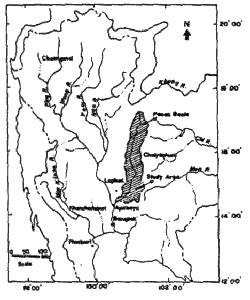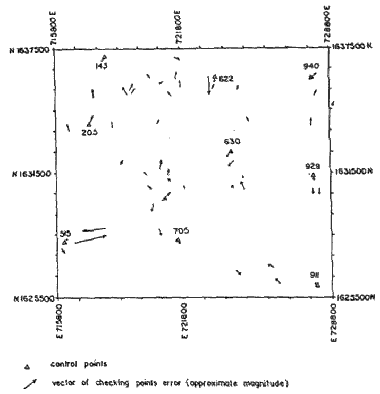| GISdevelopment.net ---> AARS ---> ACRS 1996 ---> Poster Session 1 |
Using High Resolution
Satellite Imageries to updata Topographic map and for Monitor Land use
Changes
Komate
Hongpakdee1, Pipat Sonwong 1, Suwana Euwaanon
2, Krisna Klindad 2 and orawn Sudchukiat
2
1Kasetsart University, Bangkok, Thailand Tel 579475
2Royal Irrigation Department, Nonthaburi, Thailand Tel 5838436
Abstract1Kasetsart University, Bangkok, Thailand Tel 579475
2Royal Irrigation Department, Nonthaburi, Thailand Tel 5838436
Knowledge of national resources, land use and land cover information are essential for successful regional planning and land development. Satellite imageries have been proved as an efficient information for land use mapping, imageries have been proved as an efficient information for land use mapping. It is increasingly being used for cost effective information extraction pertaining to earth surface. This paper report a practical application SPOT PLA for Topographic mapping revision and monitoring the land use changes. The planemetic accuracy was investigated.
Three mathematics algorithms AFFINE ORTHOGONAL POLYNOMAIL coordinates transformation were applied to compare accuracy achieved and the effectiveness of each in detecting blunder of ground controls.
The report demonstrates a practical application of SPOT PLA to up-date a topographic map at scale 1:20,000 regarding geometric accuracy.
Introduction
Pasak Basin covers 14,000 sq. km. Situated at central part of Thailand. The government planned to build a dam at the study area for irrigation purpose and flood release in Chaopya Basin especially the Bangkok Metropolis and the sub-urbans. The reservoir storae is approximated 9,000 m.cu.m.
A feasibility study had been tried by using available topographic map at scale 1:10,000 with 1 meter contour interval prepared in 1973 by photogrammetry. Due to large changes of land use in 1973 compared to 1989, an up-to-data topographic map is needed.
- Aims of Works, Problems and Solution
- Collecting up-to-data land cover information only in planemetric details.
- The ground survey or photogrammetry is time consuming and expensive.
- With the advent of high resolution satellites, a new dimension was added to the field of land cover information collection of this project, e.g. updating the 16 year-old map at the dam site area by using SPOT PLA.
- Data Used and Working Area
The work was emphasized on the planemetric accuracy of images of SPOT PLA to updata map details. The scene center is at latitude 14.9 degree N and 101.5 degree E acquired on 1989-02-09.
The image has following characteristics- Near vertical (<3 degrees camera till angle)
- Covers most part of the reservoir and damsite
- 0 % cloud cover
- Highest resolution satellite imagery monitoring in Thailand
3.1 52 points which are discernible and identifiable on both ground and on the image were selected as control points for coordinates transformation and for independent checking point to verify the planemetric accuracy of the SPOT PLA.
3.2 The selected points are undoubtful in identification and identity.
3.3 The control and the independent checking points were surveyed by third order traversing, originate from and closed to existing monuments which were surveyed by second order accuracy.
3.4 Since the working area covers 12.8 x 12.3 sq km which is equivalent to 1280 x 1230 dots or pixels, the area then was devided into 9 sub-images. Each sub-image contains 640 x 80 pixels to fit a monochrome VGA monitor that can display one sub-image at a time.
The sub_image has overlaps to the adjacent sub-image.
3.5 The 9 sub-image displayed on monitor were digitized obtaining row and column number of those 52 surveyed points.
3.6 The pre-selected control points of 4-6-8-9 points digitized were verified according to mathematics algoritas as mentioned.
The unknown parameters were calculated to transform digitized data to be UTM nothing and easing coordinates.
3.7 Land use changes such as new roads, boundary of residents, rice fields, plantation, forest etc. were digitized. The row and column number were transferred to be UTM coordinates.
3.8 Output of digitized features is a hard copy by using a pen plotter.
4. Result and Discussion
Four control points, 12 km apart, at the corners of the image are sufficient to transfer digitized features to obtain planemetric accuracy within 7 (seven) meters.
AFFINE mathematics seems to be the best in coordinates transformation in comparison with ORTHOGONAL and POLYNOMIAL.
However, a control point which is mis-identified or wrong surveyed nay jeopardize the map updated in views of geometric accuracy.
AFFINE is the least effective method in detecting blunder of a control point while ORTHOGONAL is the best.
Therefore, using only 4 ground controls, within some 10km apart, at the corners of the area, the validity of coordinates and digitized data should be checked prior to coordinates transformation be made.
The report demonstrates only roads (new or re-allocated), main canals and boundaries of main features were updated. Minute details such as new building, cart track, fences etc. were not updated due to difficulties in interpretation of these features.
It must be noted that, some minute details such as a house that is contrast to the surroundings or even a rail road are interpretably by SPOT PLA displayed on VGA monochrome (a historgram equalization).
The methodology mentioned in this report works well with flat and medium hilly terrain, and by using near vertical angle imagery.
For mountainous area and off nadir viewing angle, relief displacement and image rectification must be calculated for coordinates transformation.


Fig. 1 Study area

Fig. 2 Location of 52 checking points and ground control
5. Conclusion
The outstanding advantages of the application of SPOT PLA by using this methodology is time and cost savings. The plaemetric accuracy of the digitized features can be achieved within 7 meters which is sufficient to update map (the interpretable features) at scale up to 1:20,000. Further, the digital nature of satellite data facilities data handling and data conversion into other formats and produce map at any scale.
Acknowledgement
The work was conducted as a part of topographic map updating in Pasak Basin. It was financial supported by National Research Council. Recognition is extended to Kasetsart University and Royal Irrigation Department for their administrative and technical cooperation.
References
- G.KONECNY et. Al. Evaluation of SPOT Imagery on Analytical Photogrammetric Instruments, Photogrammetric Engineering and Remote Sensing, Vol. 53 No. 9, Sept. 1987, pp 1223-1230.
- Paul H. Salamonowicz, Satellite Orientation and Position for Geometric Correction of Scanner Imagery, Photogrametric Engineering and Remote Sensing, Vol. 52 No. 4, April 1986, p 491-499.
- S.D. DeGloria and A.S. Benson, Interpretability of Advanced SPOT Film for Forest and Agriculture Survey, Photogrammetric Engineering and Remote Sensing, Vol. 53 No. 1, January 1987, pp 37-44.
- J.R. Eyton, SPOT PLA Photographic Image Processing, Photogrammetric Engineering and Remote Sensing, Vol. 56 No. 8, August 1990, pp 1129-1134.